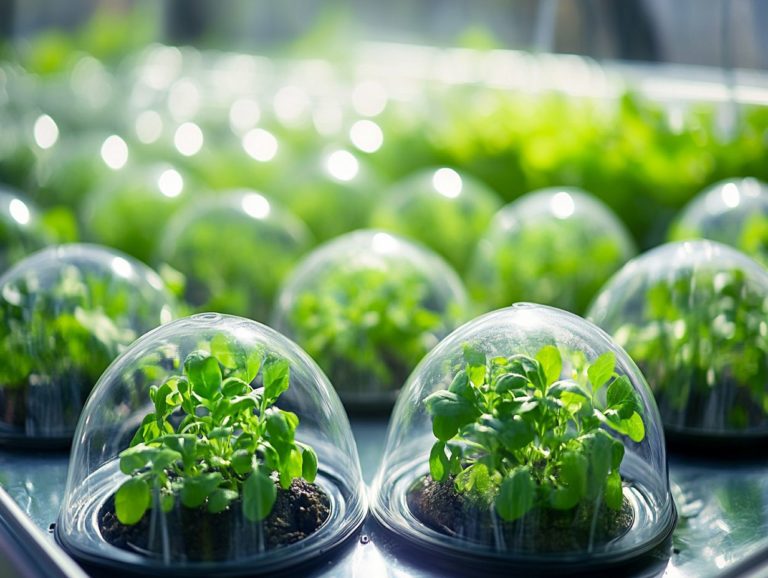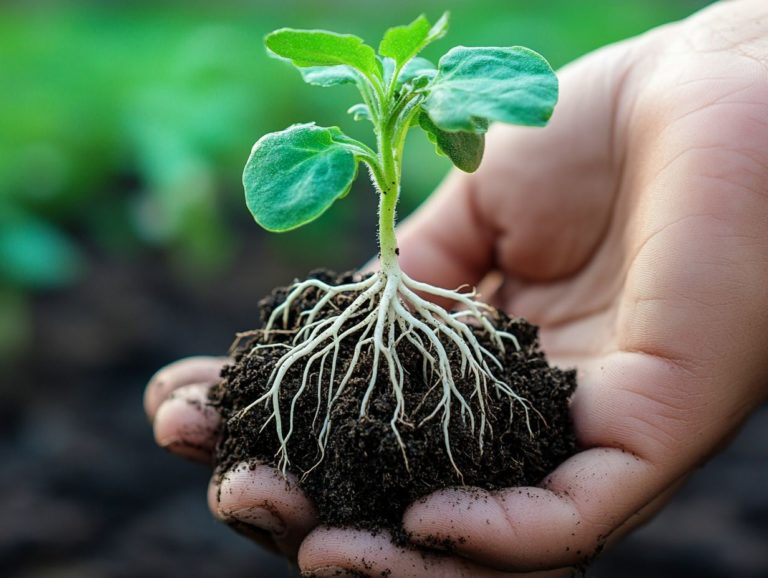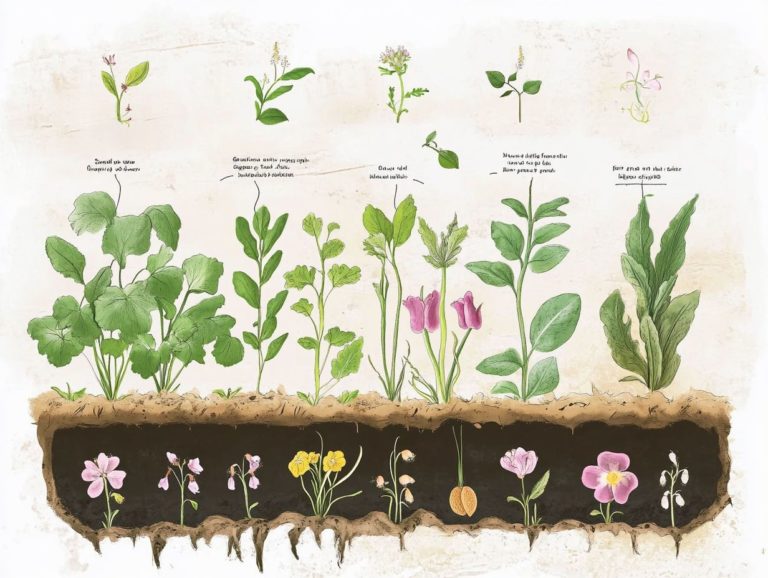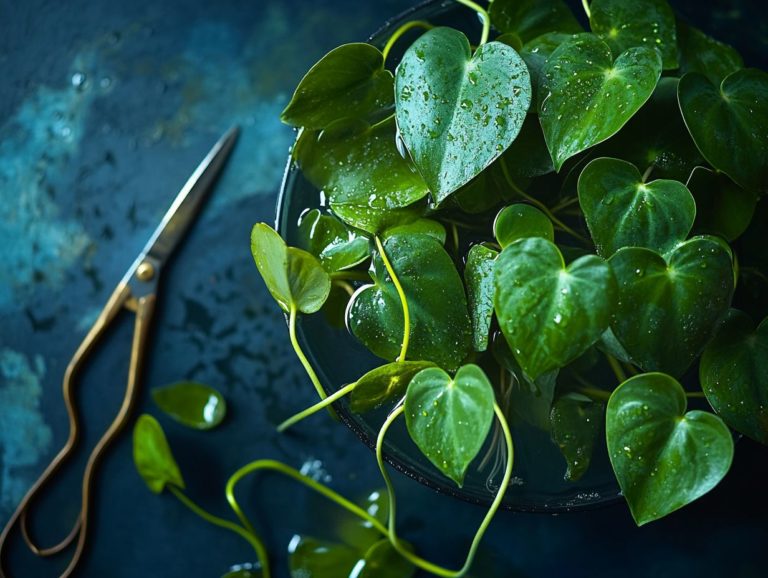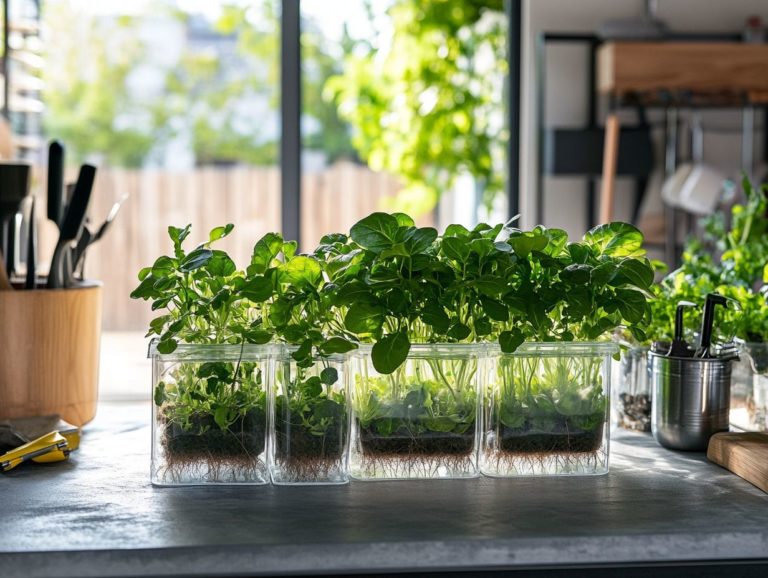Best Lighting Conditions for Plant Propagation
Plant propagation is an intriguing journey that empowers you to expand your green collection and nurture your passion for gardening.
In this adventure, lighting becomes a pivotal player.
This article delves into the critical role of light in plant growth and development, comparing the merits of natural and artificial lighting options. You ll discover the ideal conditions tailored for various plant types.
You will find practical tips and insights on common pitfalls to avoid. These strategies will help your propagation efforts flourish, especially when it comes to light conditions.
Embark on this exploration to unlock the secrets of optimal lighting for thriving plants!
Contents
- Key Takeaways:
- Understanding Plant Propagation and Propagation Methods
- Importance of Lighting in Plant Propagation
- Types of Lighting for Plant Propagation
- Ideal Lighting Conditions for Different Types of Plants
- Unlock Your Plant s Potential with Perfect Lighting!
- Common Mistakes to Avoid
- Frequently Asked Questions
- What are the best lighting conditions for propagating plants?
- Can low light harm the germination of certain seeds?
- What is the ideal amount of light for plant propagation?
- Can You Use Artificial Light for Plant Propagation?
- How Can I Tell if My Plants Are Getting Enough Light?
- Which Plants Can Be Propagated in Low Light?
Key Takeaways:
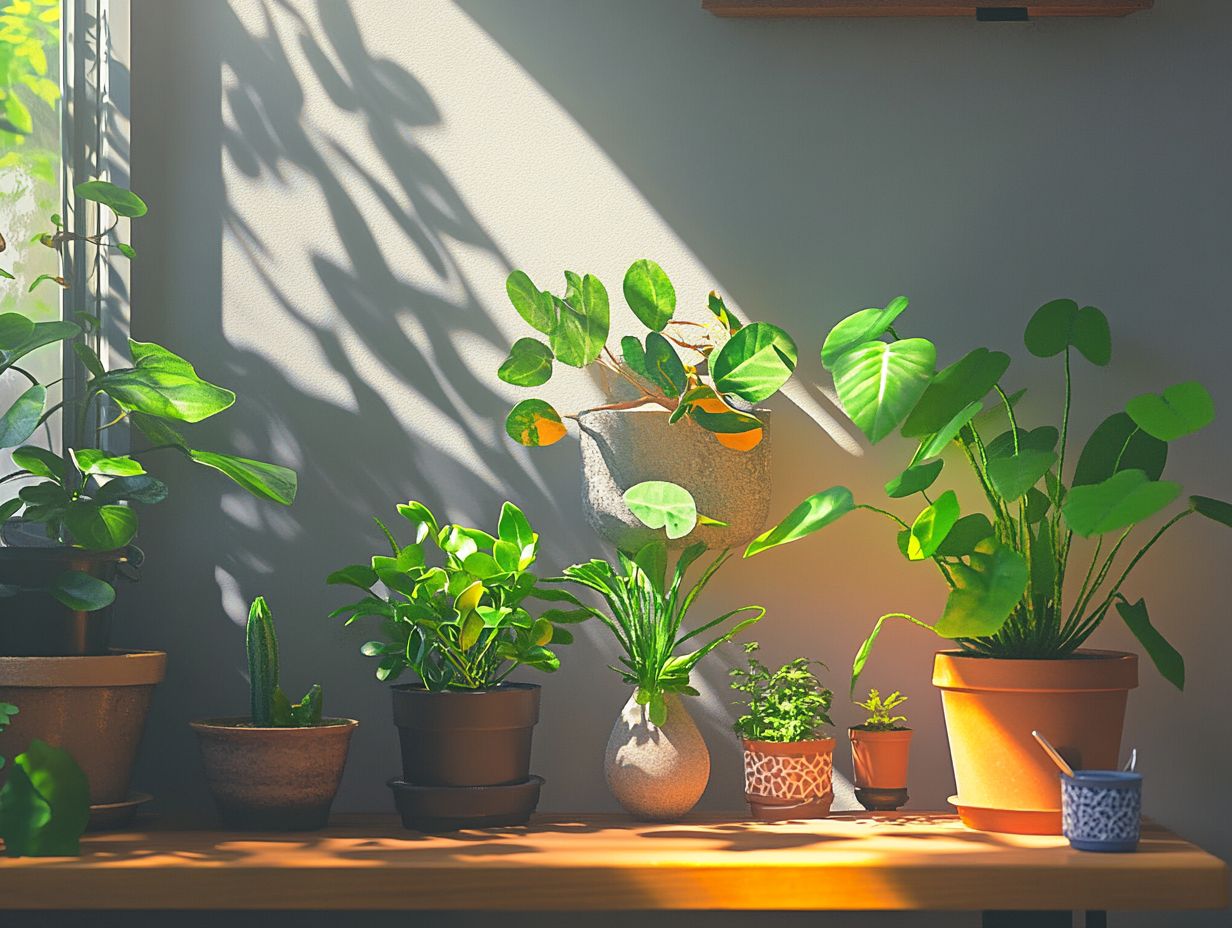
- The right lighting is crucial for successful plant propagation as it affects growth and development.
- Natural light is preferred for most plants, but artificial light can also be effective with proper positioning and intensity.
- Consider factors such as light intensity, duration, and spectrum for optimal lighting conditions.
Understanding Plant Propagation and Propagation Methods
Understanding plant propagation is crucial for anyone passionate about horticulture. It includes both asexual and sexual techniques vital for nurturing robust plants.
This intricate process goes beyond merely growing seedlings. It encompasses a range of environmental factors like light, temperature, and humidity levels that significantly influence propagation success.
Don t wait! Try various exciting methods, from cutting techniques to seed germination, tailored to the specific species and their unique needs, such as seed types and rooting hormone.
What is Plant Propagation?
Plant propagation is the art of creating new plants from existing ones. You can achieve this through a variety of methods, such as seed germination and cuttings, which contribute to the propagation phase.
This exciting practice lets you grow your plant collection and connect with nature! It also plays a vital role in preserving plant species and enhancing biodiversity. The methods you choose can vary widely, influenced by environmental factors like temperature, humidity, and soil conditions, all of which can make or break your propagation efforts.
By understanding how these elements interact, you can develop more effective cultivation strategies, leading to healthier plants and sustainable gardening practices. Furthermore, plant propagation bolsters agricultural resilience, ensuring a steady supply of crops while minimizing losses caused by pests or diseases.
Importance of Lighting in Plant Propagation
Lighting is paramount in plant propagation, directly affecting photosynthesis, the process plants use to convert sunlight into energy. When you provide adequate lighting, you ensure optimal light intensity, catering to the specific needs of various plant species during crucial stages such as seed germination and root development.
By incorporating supplemental lighting, you can greatly enhance plant growth, especially when natural light falls short, leading to improved growth rates and overall plant vitality. For more insights, consider following the best practices for indoor plant growth after propagation, which are crucial for vegetative stages.
Role of Light in Growth and Development
The importance of light in plant growth and development is truly monumental, as it drives photosynthesis, allowing you to convert light energy into chemical energy for sustaining energy reserves.
Light plays a pivotal role during critical growth phases like seed germination and root development. The right intensity can be the deciding factor between vigorous growth and stunted plants. For example, during germination, your seeds require specific wavelengths to kick off the enzymatic reactions essential for sprouting. Additionally, how temperature affects plant propagation is also crucial in this process.
Likewise, providing adequate light in the early stages fosters stronger root systems, which are vital for nutrient absorption and overall plant health.
When your plants thrive under optimal light conditions, they become more resilient against diseases, making them a key player in promoting agricultural sustainability and maintaining ecosystem balance through effective pest management.
Types of Lighting for Plant Propagation
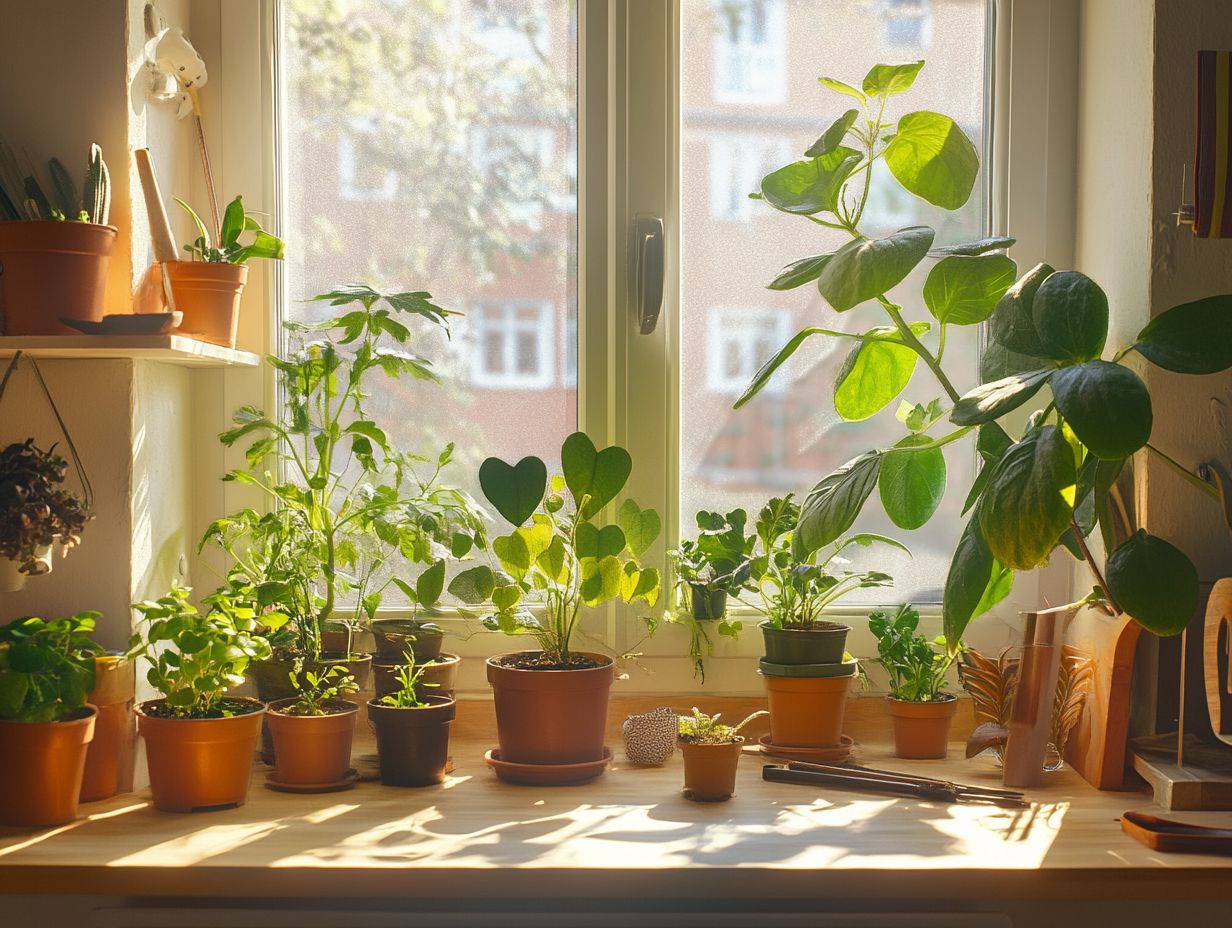
You have a range of lighting options for plant propagation, each with its unique advantages and drawbacks. While natural light is essential, it often lacks the consistent exposure that your plants crave, especially indoors.
On the other hand, artificial lighting solutions like LEDs and fluorescent lights provide supplemental lighting to create ideal conditions. These options ensure that essential processes, such as seed germination and cutting production, receive the optimal light levels they need for thriving growth. For more detailed insights, check out the best lighting techniques for indoor gardening.
Natural Light vs Artificial Light
Natural light is celebrated for delivering a full spectrum of wavelengths vital for your plants’ growth. However, artificial light allows for controllable conditions tailored to their specific needs, enhancing their nutrient supply.
Each type serves a unique purpose in plant propagation, where timing and intensity are crucial. While sunlight fluctuates throughout the day and across seasons, artificial lighting provides a consistent environment. Understanding the optimal light conditions for succulents allows you to extend the growing period, regardless of external conditions.
By skillfully integrating both natural and artificial light, you can optimize conditions to cultivate healthier, more robust crops, enhancing yields and fostering thriving ecosystems.
Ideal Lighting Conditions for Different Types of Plants
Getting the right lighting is crucial for your plants to thrive! Each plant species has its unique light requirements and preferences that directly influence growth and health. For instance, Aroid plants like Pothos and Philodendron flourish in moderate light, while others may need brighter conditions during specific growth phases.
It’s also important to maintain optimal temperature and humidity levels; these factors work hand-in-hand with light to ensure your plants develop in a healthy, vibrant manner and promote proper soil mixture.
Factors to Consider for Optimal Growth
When cultivating optimal plant growth, consider several key factors, such as light conditions, light requirements, air temperature, and humidity levels. All these elements influence the growth rate.
Sufficient light fuels photosynthesis, the process plants use to convert light into energy. It also plays a role in regulating temperature and retaining moisture in the soil. If your plants don t receive adequate light, they may weaken and struggle to absorb water and nutrients effectively, leading to stunted growth and increased susceptibility to disease.
Maintaining the right humidity levels is vital too. High humidity can slow down transpiration, while low humidity can cause the soil to dry out rapidly. The balance of these variables ultimately determines the vitality of your plants, affecting not just their growth rates but also their resilience against environmental stressors.
Unlock Your Plant s Potential with Perfect Lighting!
Creating the perfect lighting conditions for your plants requires careful attention to light exposure, intensity, and the strategic placement of light sources. By thoughtfully considering these elements, you can foster an environment that promotes optimal growth and vitality.
Here are some tips for achieving the best lighting conditions:
- Assess your plants’ specific light needs.
- Use a mix of natural and artificial light.
- Position light sources to avoid shadows.
- Monitor light intensity and adjust as necessary.
- Regularly check your plants for signs of light stress.
Start optimizing your plant lighting today and watch them thrive!
How to Adjust Light Levels and Positioning

Adjusting light levels and positioning is crucial for maximizing light exposure and meeting the specific needs of your plants, especially their water requirements.
By changing how far your lights are from the plants, whether you’re using natural sunlight or artificial grow lights, you can effectively tailor the intensity and duration of light each plant receives. For example, moving a light source closer can ramp up the intensity, which is perfect for light-loving species. Conversely, more delicate varieties may thrive better with a softer glow from a distance. For further insights, consider the lighting considerations for plant growth.
Knowing what your plants need for light is crucial to their thriving! Understanding the diverse needs of plants is vital, as light positioning impacts growth rates and the overall vitality of your plants.
Techniques like rotating plants or adjusting light fixtures can greatly improve their health and development.
Common Mistakes to Avoid
Steering clear of common mistakes in lighting conditions is essential for nurturing healthy plants. Improper light exposure can hinder their growth and lead to various health problems.
By paying attention to their lighting needs, you can create a thriving environment for your plants to flourish.
Lighting Pitfalls to Watch Out For
Common lighting pitfalls include insufficient light exposure, excessive light levels, and poor positioning of light sources. All of these can significantly impede plant growth.
These issues can lead to complications like stunted growth or unhealthy leaf development, which can hinder root development and overall plant growth.
When light exposure is insufficient, plants may become leggy, stretching out in a desperate bid for light. On the flip side, excessive lighting can result in leaf burn and unsightly discoloration, both signs that something is off.
Additionally, poor positioning can cast shadows that deprive certain areas of a plant, stunting its overall growth.
Understanding the specific light requirements for different species is essential, as each type has its own unique tolerances and needs. Meeting these requirements is vital for achieving optimum health.
Frequently Asked Questions
What are the best lighting conditions for propagating plants?
The best lighting conditions for plant propagation typically include bright, indirect light. Supplementing with artificial light can enhance exposure, especially during flowering. This means placing the plants near a window with a sheer curtain or in a room that receives natural light but isn t exposed to direct sunlight.
Can low light harm the germination of certain seeds?

While it is possible to propagate plants in low light conditions, it may not yield the best results. Low light can slow down the growth of new plants, causing them to become leggy or weak.
What is the ideal amount of light for plant propagation?
The ideal amount of light for plant propagation is around 12-16 hours of bright, indirect light each day, ensuring optimal temperature and humidity. This mimics greenhouse conditions and promotes healthy growth and development of new plants.
Can You Use Artificial Light for Plant Propagation?
Yes, you can use artificial light for plant propagation. LED grow lights and fluorescent lights are perfect for this as they mimic natural light.
How Can I Tell if My Plants Are Getting Enough Light?
Look for signs like new growth and sturdy stems. Weak stems or yellow leaves suggest your plants need more light.
Which Plants Can Be Propagated in Low Light?
Certain plants thrive in low light, such as Pothos, Chinese Evergreens, and Snake Plants. These can be successfully propagated even in dim conditions.


